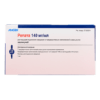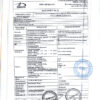No products in the cart.
Repata, 140 mg/ml 1 ml syringe pens
€1.00
Out of stock
(E-mail when Stock is available)
Description
Mechanism of Action
Evolocumab is a fully human monoclonal immunoglobulin G2 (IgG2) that inhibits proprotein convertase subtilisin/kexin type 9 (PCSK9). Evolocumab selectively and with a high degree of affinity binds to PCSK9 and inhibits the binding of circulating PCSK9 to the low-density lipoprotein receptor (LDL) on the surface of liver cells, thus preventing PCSK9-mediated breakdown of LDL. As a result, increased expression of R-LDL in the liver leads to a decrease in the serum concentration of low-density lipoprotein cholesterol (LDL-C).
Pharmacodynamic properties
. In patients with primary hyperlipidemia and mixed dyslipidemia, involocumab has been shown to reduce concentrations of unbound PCSK9, LDL-C, total cholesterol (TC), apolipoprotein B (apoB), low-density lipoprotein cholesterol (non-LDL-C), very low density lipoprotein cholesterol (VLDL-C), triglycerides and lipoprotein(a) (Lp[a]), increases concentrations of high density lipoprotein cholesterol�009(HDL-C) and apolipoprotein A1(apoA1), improving the ratio OS/CS-LDL, apoB/apolipoprotein A1 (apoA1).
A single subcutaneous injection of 140 or 420 mg of involocumab results in maximal suppression of cycling unbound PCSK9 after 4 hours, accompanied by a decrease in LDL-C reaching mean nadir by 14 and 21 days, respectively. Changes in unbound PCSK9 and serum lipoprotein concentrations are reversible after withdrawal of involocumab.
There was no compensatory increase in PCSK9 and LDL-C production during treatment, and no increase in unbound PCSK9 or LDL-C concentrations (no “ricochet syndrome”) was noted after evolocumab withdrawal. With the dosing regimen of 140 mg evolocumab every two weeks or 420 mg evolocumab once a month, maximum reductions in LDL-C achieved from -72% to -57% of initial values compared with placebo. The dosing regimens were equivalent with respect to the average decrease in LDL-C (mean at weeks 10 and 12).
A similar decrease in LDL-C was observed both when using involocumab in monotherapy and as part of combination therapy with other hypolipidemic drugs. The effect with regard to LDL-C decrease is stable, the maximum duration of therapy is currently 112 weeks.
External and internal factors such as demographic characteristics, concurrent therapy, variability of laboratory parameters and disease status have no effect on the response to therapy with everolocumab (see “Dosing regimen”.
Immunogenicity
As with any therapeutic protein, there is a potential risk of immunogenicity.Immunogenicity was determined by
immunochemiluminescence binding to detect antibodies to involocumab. If patients were found to have antibodies to involocumab during immunological screening, an additional biological assay was performed to assess whether these antibodies were neutralizing.
In clinical trials, 0.1% of patients (7 of 4,846 patients with primary hypercholesterolemia and mixed dyslipidemia and none of 80 patients with homozygous familial hypercholesterolemia [HFHH]) who received at least 1 dose of involocumab were found to have binding antibodies (4 patients had transient antibodies).
An additional neutralizing antibody assay was performed for these patients. Neutralizing antibodies were not detected in any of the patients. The detected binding antibodies did not alter the pharmacokinetic parameters of the drug and did not affect the therapeutic response or safety of the drug. Clinical efficacy and safety
The results of clinical studies of involocumab prove that inhibition of PCSK9 activity by involocumab provides a decrease in the concentration of LDL-C in serum and improve other parameters of lipid metabolism. These results demonstrate stable efficacy of involocumab in improving lipid metabolism parameters in patients with primary hyperlipidemia (heterozygous familial and non-familial) and mixed dyslipidemia and GOSHCHS in all populations and with any study design.
The 140 mg bi-weekly (Q2W) and 420 mg (QM) evolocumab monthly dosing regimens are clinically equivalent in patients with primary hypercholesterolemia and mixed dyslipidemia with respect to decreases in LDL-C, total cholesterol, apoB, non-LDL-C, LDL-C, triglycerides and Lp(a); increase of concentration of HDL and ApoA1 and improvement of the ratio of total cholesterol/HDL, ApoB/ApoA1.
Evolocumab therapy resulted in a decrease in LDL-C concentrations of approximately 55-75%, which persisted throughout the duration of long-term therapy. Maximum response was generally achieved 12 weeks after administration of 140 mg times Q2W and 420 mg QM, respectively. In 80-85% of patients receiving devolocumab at any dosage, there was a reduction in LDL-C concentrations of more than 50% on average by 10 to 12 weeks of use.
. Evolocumab was superior to ezetimibe in reducing LDL-C concentrations, Evolocumab 140 mg Q2W and 420 mg QM was effective in all placebo and ezetimibe subgroups, with no significant differences between subgroups defined by patient characteristics such as age, race gender, region of origin, body mass index (BMI), National Cholesterol Education Program (NCEP) risk score, statin dose and intensity, smoking status, baseline risk of coronary heart disease (CHD), early CHD family history, glucose tolerance or intolerance (ie.е. type 2 diabetes mellitus, metabolic syndrome, or neither), arterial hypertension, baseline unbound PCSK9, baseline LDL-C concentration, and baseline triglyceride concentration, were not observed.
The results of the overall efficacy analysis in the GOSHCS trials suggest that everolocumab effectively reduced concentrations of CHD-LDL, total cholesterol, apoB, and non-HLDP in patients with GOSHCS.
Long-term treatment with involocumab at doses of 420 mg QM and 420 mg Q2W showed a prolonged therapeutic effect, which was confirmed by a decrease in LDL-C concentrations of approximately 20% to 30% in patients with GOSHCA who did not receive apheresis treatment and approximately 15% to 25% in patients with GOSHCA who received apheresis. Overall, no differences were observed with respect to the safety or efficacy of involocumab between groups aged 12 years and older and adult patients with GOSHCS.
The ratio of patients with adverse events was generally balanced between groups during all 3 periods of composite safety data collection, as well as between subgroups and treatment regimens.
There were no safety concerns regarding adverse events reported for other hypolipidemic therapies (i.e., episodes of diabetes mellitus and liver and muscle complications) and events that could theoretically be associated with PCSK9 inhibition/increased LDL receptor expression (i.e., hepatitis C episodes). There were no indications of any risk of neurocognitive complications with the use of everolucumab. Neurocognitive complications in studies with placebo or active controls were similar.
Types and number of adverse events in all studies were comparable, both when using involocumab as monotherapy and as part of combination therapy (with statins in combination with or without ezetimibe) or in patients with intolerance to statins.
No new drug safety signals were identified in a comparative study of adverse event data developed in studies of patients with GOSHS and adverse event data developed in studies of primary hyperlipidemia (heterozygous familial and nonfamilial) and mixed dyslipidemia.
Pharmacokinetics
The pharmacokinetics of involocumab after subcutaneous administration demonstrate a nonlinear pattern.
absorption
The median maximum serum concentration was reached within 3 to 4 days with an estimated absolute bioavailability of 72% after a single subcutaneous injection of evolocumab 140 mg or 420 mg in healthy volunteers. The mean maximum concentration (Cmax mean (SD)) was 18.6 (7.3) mcg/ml after a 140 mg dose. The final area under the concentration-time curve (AUClast) was 188 (98.6) days “μg/ml. Similar Cmax and AUClast values were 59.0 (17.2) mcg/ml and 924 (346) 24 hours “mcg/ml, respectively, after administration of the 420 mg dose.
Distribution
The mean estimated equilibrium distribution volume was 3.3 (0.5) L after a single 420 mg dose of involocumab administered intravenously, suggesting limited tissue distribution of involocumab.
Metabolism
The calculated mean systemic clearance was 12 (2) mL/h after a single intravenous injection of 420 mg of involocumab. Repeated subcutaneous administration of involocumab for 12 weeks in clinical trials resulted in dose-proportional increases in exposure for dosing regimens of 140 mg or greater. Approximately two- and threefold cumulation was observed at a minimum serum concentration (Cmin [SD]) of 7.21 [6.6]) with dosing regimens of 140 mg every 2 weeks or 420 mg once a month (Cmin [SD] 11.2 [10.8]). The minimum serum concentration reached an equilibrium state by 12 weeks of dosing. The calculated effective elimination half-life of everolucumab was 11 to 17 days. There were no time-related changes in evolocumab serum concentrations over 124 weeks.
Evolocumab
Because evolocumab is a fully human IgG2 monoclonal antibody, evolocumab clearance is due to specific binding and complex formation with the target ligand, PCSK9, as are the standard IgG clearance pathways in the reticulo-endothelial system. Evolocumab is broken down to small peptides and amino acids via these catabolic pathways.
An increase in clearance of approximately 20% has been noted when combined with statins. This increase is due in part to the statin-induced increase in PCSK9 concentrations and does not adversely affect the pharmacodynamics of involocumab with respect to lipids. Population-based pharmacokinetic analysis showed no significant differences in the serum concentrations of involocumab in patients with hypercholesterolemia (familial and non-familial), while taking statins simultaneously.
Separate patient groups
According to the results of pharmacokinetic analysis in populations no dose adjustments based on age, race or sex are required. Body weight affects the pharmacokinetics of involocumab, but has no significant effect on the hypolipidemic effect of involocumab. Consequently, dosing regimen adjustment depending on body weight is not required.
Pharmacokinetic analysis in populations by pooled data from clinical trials revealed no differences in the pharmacokinetics of the drug in patients with mild to moderate renal dysfunction compared to patients with normal renal function.
The drug was administered as a single subcutaneous injection of 140 mg to 8 patients with mild renal dysfunction, 8 patients with moderate renal dysfunction and 8 healthy volunteers. Exposure to involocumab was reduced by 40% to 50% compared with healthy volunteers. Nevertheless, baseline PCSK9 concentrations as well as the degree and time of PCSK9 neutralization remained similar in all three groups. Thus, there was a similar effect on the reduction of LDL-C.
Indications
Indications
-Primary hyperlipidemia and mixed dyslipidemia
Repatha is indicated for adults with primary hyperlipidemia (heterozygous familial and non-familial) and mixed dyslipidemia (Fredrickson types IIa, IIb, IV) as an adjunct to diet to lower LDL-C, total in combination with a statin or in combination with a statin and other lipid-lowering therapy (eg, ezetimibe), or
-In monotherapy or in combination with other lipid-lowering therapy in patients intolerant to statins, or
-In monotherapy or in combination with other lipid-lowering therapy in patients in whom the use of statins is considered inappropriate from a clinical point of view.
– Homozygous familial hypercholesterolemia (HoFH)
Repata is indicated for use in adult patients and adolescents aged 12 years and older with HoFH (Fredrickson type IIa) to reduce concentrations of LDL-C, TC, ApoB, and non-HDL-C in combination with other lipid-lowering therapy (eg, statins, LDL apheresis).
Pharmacological effect
Pharmacological effect
Mechanism of action
Evolocumab is a fully human monoclonal immunoglobulin G2 (IgG2) that inhibits proprotein convertase subtilisin/kexin type 9 (PCSK9). Evolocumab binds selectively and with high affinity to PCSK9 and inhibits the binding of circulating PCSK9 to the low-density lipoprotein receptor (LDL-R) on the surface of liver cells, thereby preventing PCSK9-mediated breakdown of LDL-R. As a result, increased expression of LDL-R in the liver leads to a decrease in serum concentrations of low-density lipoprotein cholesterol (LDL-C).
Pharmacodynamic properties
In patients with primary hyperlipidemia and mixed dyslipidemia, evolocumab has been shown to reduce concentrations of unbound PCSK9, LDL-C, total cholesterol (TC), apolipoprotein B (ApoB), non-high-density lipoprotein cholesterol (non-HDL-C), very low-density lipoprotein cholesterol (VLDL-C), triglycerides, and lipoprotein(a). (Lp[a]), increases the concentrations of high-density lipoprotein cholesterol�009 (HDL-C) and apolipoprotein A1 (ApoA1), improving the ratio of OC/HDL-C, ApoB/apolipoprotein A1 (ApoA1).
A single subcutaneous injection of 140 or 420 mg evolocumab resulted in maximal suppression of circulating unbound PCSK9 at 4 hours, accompanied by a reduction in LDL-C reaching a mid-nadir at days 14 and 21, respectively. Changes in unbound PCSK9 and serum lipoprotein concentrations are reversible after discontinuation of evolocumab.
There was no compensatory increase in the production of PCSK9 and LDL-C during treatment, nor was there an increase in the concentrations of unbound PCSK9 or LDL-C after withdrawal of evolocumab (no “rebound syndrome”). With a dosing regimen of 140 mg evolocumab every two weeks or 420 mg evolocumab once a month, the maximum reduction in LDL-C reached from -72% to -57% of baseline values compared with placebo. Dosing regimens are equivalent in terms of mean reduction in LDL-C (average at weeks 10 and 12).
A similar decrease in LDL-C was observed both when using evolocumab in monotherapy and as part of combination therapy with other lipid-lowering drugs. The LDL-C lowering effect is stable, and the maximum duration of therapy is currently 112 weeks.
External and internal factors such as demographic characteristics, concomitant therapy, laboratory variability and disease status do not affect the response to evolocumab therapy (see Dosage Regimen).
Immunogenicity
As with any therapeutic proteins, there is a potential risk of developing immunogenicity. Immunogenicity was determined using
immunochemiluminescent binding to detect antibodies to evolocumab. If antibodies to evolocumab were detected in patients during immunological screening, an additional biological analysis was performed to assess whether these antibodies were neutralizing.
In clinical studies, 0.1% of patients (7 of 4846 patients with primary hypercholesterolemia and mixed dyslipidemia and none of 80 patients with homozygous familial hypercholesterolemia [HoFHH]) who received at least 1 dose of evolocumab had binding antibodies (4 patients had transient antibodies).
For these patients, additional testing for neutralizing antibodies was performed. Neutralizing antibodies were not detected in any of the patients. The detected binding antibodies did not lead to changes in the pharmacokinetic parameters of the drug and did not affect the therapeutic response or safety of the drug. Clinical efficacy and safety
Results from clinical studies of evolocumab demonstrate that inhibition of PCSK9 activity by evolocumab reduces serum LDL-C concentrations and improves other parameters of lipid metabolism. These results demonstrate the consistent effectiveness of evolocumab in improving lipid metabolism in patients with primary hyperlipidemia (heterozygous familial and non-familial) and mixed dyslipidemia and HoFH in all populations and with any study design.
Dosing regimens of evolocumab 140 mg every two weeks (Q2W) and evolocumab 420 mg (QM) once monthly are clinically equivalent in patients with primary hypercholesterolemia and mixed dyslipidemia in reducing LDL-C, total cholesterol, ApoB, non-HDL-C, VLDL-C, triglycerides, and Lp(a); increasing the concentration of HDL-C and ApoA1 and improving the ratio of total cholesterol/HDL-C, ApoB/ApoA1.
As a result of therapy with evolocumab, a decrease in LDL-C concentrations of approximately 55-75% was achieved, which was maintained throughout the entire period of long-term therapy. Maximum response was typically achieved 12 weeks after administration of 140 mg Q2W and 420 mg QM, respectively. 80-85% of patients receiving evolocumab at any dosage experienced a decrease in LDL-C concentrations of more than 50% by an average of 10-12 weeks of use.
Evolocumab was superior to ezetimibe in lowering LDL-C concentrations. Evolocumab 140 mg Q2W and 420 mg QM were effective in all placebo and ezetimibe subgroups, with no significant differences between subgroups defined by patient characteristics such as age, race, sex, region of origin, body mass index (BMI), National Cholesterol Education Program (NCEP) risk score, statin dose and intensity, smoking status, baseline coronary artery disease (CAD) risk, family history of early CAD, glucose tolerance or intolerance (ie, type 2 diabetes mellitus, metabolic syndrome, or neither), hypertension, baseline unrelated PCSK9, baseline LDL-C concentration, and baseline triglyceride concentration were not observed.
Results from the overall efficacy analysis in the HoFH trials suggest that evolocumab was effective in reducing LDL-C, total cholesterol, ApoB, and non-HDL-C concentrations in patients with HoFH.
With long-term treatment with evolocumab at doses of 420 mg QM and 420 mg Q2W, a prolonged therapeutic effect was observed, as evidenced by a decrease in LDL-C concentrations of approximately 20% to 30% in HoFH patients not treated with apheresis and in approximately 15% to 25% of HoFH patients treated with apheresis. Overall, no differences in the safety or efficacy of evolocumab were observed between groups aged 12 years or older and adult patients with HoFH.
The proportion of patients experiencing adverse events was generally balanced between groups across all 3 comprehensive safety data periods and between subgroups and treatment regimens.
There were no safety concerns regarding adverse events reported for other lipid-lowering therapies (i.e., episodes of diabetes mellitus and liver and muscle complications) or events that may theoretically be associated with PCSK9 inhibition/increased LDL receptor expression (i.e., episodes of hepatitis C). There were no signs indicating a risk of developing neurocognitive complications with evolocumab. Neurocognitive complications were similar between placebo and active control studies.
The types and numbers of adverse events were comparable across all studies, whether evolocumab was used as monotherapy or as part of combination therapy (with or without statins with or without ezetimibe) or in patients intolerant to statins.
No new safety signals were identified when comparing adverse event data from studies of HoFH patients with adverse event data from studies of primary hyperlipidemia (heterozygous familial and nonfamilial) and mixed dyslipidemia.
Pharmacokinetics
The pharmacokinetics of evolocumab after subcutaneous administration shows a non-linear pattern.
Suction
Median maximum serum concentrations were achieved within 3 to 4 days with an estimated absolute bioavailability of 72% after a single subcutaneous injection of evolocumab 140 mg or 420 mg in healthy volunteers. The average maximum concentration (Cmax mean (SD)) was 18.6 (7.3) μg/ml after administration of a dose of 140 mg. The final area under the concentration-time curve (AUClast) was 188 (98.6) days µg/ml. Similar Cmax and AUClast values were 59.0 (17.2) μg/ml and 924 (346) μg/ml day, respectively, after administration of a dose of 420 mg.
Distribution
The mean estimated volume of distribution at steady state was 3.3 (0.5) L after a single dose of 420 mg IV evolocumab, suggesting limited tissue distribution of evolocumab.
Metabolism
The calculated mean systemic clearance was 12 (2) ml/h after a single 420 mg intravenous dose of evolocumab. Repeated subcutaneous administration of evolocumab over 12 weeks in clinical studies resulted in a dose-proportional increase in exposure for dosing regimens of 140 mg or greater. Approximately two- to three-fold accumulation was observed at minimum serum concentrations (Cmin [SD]) of 7.21 [6.6]) with dosing regimens of 140 mg every 2 weeks or 420 mg once monthly (Cmin [SD] 11.2 [10.8]). Trough serum concentrations reached equilibrium by week 12 of dosing. The estimated effective half-life of evolocumab was 11 to 17 days. There were no time-related changes in evolocumab serum concentrations over 124 weeks.
Removal
Because evolocumab is a fully human IgG2 monoclonal antibody, clearance of evolocumab is due to specific binding and complexation with the target ligand, PCSK9, as well as standard IgG clearance pathways in the reticuloendothelial system. Evolocumab is broken down into small peptides and amino acids through these catabolic pathways.
An increase in clearance of approximately 20% was observed when combined with statins. This increase is due in part to a statin-induced increase in PCSK9 concentrations and does not adversely affect the lipid pharmacodynamics of evolocumab. Pharmacokinetic analysis in populations did not reveal significant differences in serum concentrations of evolocumab in patients with hypercholesterolemia (familial and non-familial) while taking statins.
Selected patient groups
Based on the results of pharmacokinetic analysis in populations, no dose adjustment is required depending on age, race or gender. Body weight affects the pharmacokinetics of evolocumab, but does not significantly affect the lipid-lowering effect of evolocumab. Therefore, adjustment of the dosage regimen depending on body weight is not required.
Pharmacokinetic analysis in populations based on pooled clinical trial data did not reveal differences in the pharmacokinetics of the drug in patients with mild to moderate renal impairment compared with patients with normal renal function.
The drug was administered as a single subcutaneous injection of 140 mg to 8 patients with mild liver dysfunction, 8 patients with moderate impairment, and 8 healthy volunteers. Exposure to evolocumab was reduced by 40% – 50% compared to healthy volunteers. However, baseline PCSK9 concentrations and the extent and timing of PCSK9 neutralization remained similar in all three groups. Thus, a similar effect on lowering LDL-C was observed.
Special instructions
Special instructions
Before initiating therapy with Repata, possible secondary causes of hyperlipidemia or mixed dyslipidemia (eg, diabetes mellitus, hypothyroidism, nephrotic syndrome) should be assessed and measures should be taken to adequately control associated diseases (see also section “CAUTIONS”).
Liver failure
In patients with moderate hepatic impairment, decreased exposure to evolocumab was observed, which could potentially lead to decreased effect on LDL-C. Patients with severe hepatic impairment (Child-Pugh class C) were not included in clinical studies.
Increased activity of creatine phosphokinase
Patients with creatine phosphokinase activity greater than 3 times the upper limit of normal were not included in clinical studies. However, clinical studies did not detect safety signals in the form of muscle adverse events or increased creatine phosphokinase activity.
Thyroid dysfunction
Patients with uncontrolled thyroid dysfunction (TSH > 1.5 above and below normal) were not included in clinical studies until adequate control of the disease was achieved. During clinical trials, adverse events of hypothyroidism or hyperthyroidism were reported at approximately the same frequency across all treatment groups, less than 0.3%.
Unstable angina
Patients with unstable angina were not included in clinical studies. Long-term safety data from open-label phase studies of evolocumab showed that the risks of major cardiovascular events and hospitalizations for unstable angina and heart failure did not increase (hazard ratio 0.5 (95% CI 0.29, 0.86)).
Severe arrhythmias
Patients with severe cardiac arrhythmias were not included in clinical studies. A separate assessment of cardiac adverse events showed that the incidence of new electrocardiogram abnormalities was comparable between the evolocumab and control groups in the studies, and cardiac adverse events were rarely reported. Similar results were obtained when adverse reactions potentially associated with increased repolarization were analyzed separately. The analysis did not reveal any effect of evolocumab on the QT/QTc interval.
Arterial hypertension
Patients with uncontrolled hypertension (systolic blood pressure > 180 mmHg or diastolic blood pressure > 110 mmHg at rest) were not included in clinical studies. Analysis of mean changes from baseline in systolic and diastolic blood pressure did not reveal any significant differences in the evolocumab or control groups in clinical trials.
Chronic heart failure
Patients with chronic heart failure (NYHA functional classes III and IV) were not included in clinical studies. During clinical trials, adverse events of heart failure or chronic heart failure were reported at approximately the same rate across all treatment groups, less than 0.3%. Long-term safety data from open-label phase studies of evolocumab showed that the risks of major cardiovascular events and hospitalizations for unstable angina and heart failure did not increase (hazard ratio 0.5 (95% CI 0.29, 0.86)).
Diabetes mellitus
Patients with type 1 diabetes mellitus or decompensated type 2 diabetes mellitus (HbA1c > 8.5%) were not included in clinical studies. A separate assessment of adverse reactions showed that changes in glycosylated hemoglobin and fasting glucose were comparable in all study groups. No clinically significant differences were found in the safety analysis in the subgroup of patients with type 2 diabetes mellitus.
Use as part of combination therapy
When prescribing Repata with other lipid-lowering drugs (for example, ezetimibe, statins), contraindications and special instructions given in the approved instructions for use of other drugs should be taken into account.
Influence on the ability to drive a car and work with machinery
There have been no studies of the effect on the ability to drive vehicles and operate mechanisms that require increased concentration.
The needle cap for PZSh and PZTTTR consists of natural rubber derived from latex. Tell your doctor if you are allergic to latex.
Active ingredient
Active ingredient
Evolocumab
Composition
Composition
Each pre-filled syringe (PFS) contains:
Active substance:
140 mg evolocumab in 1.0 ml solution.
Excipients:
Proline – 25 mg;
Glacial acetic acid – 1.2 mg;
Polysorbate 80 – 0.1 mg;
Sodium hydroxide – in the amount necessary to bring the pH to 5.0;
Water for injection in the amount necessary to bring the volume to 1 ml.
Contraindications
Contraindications
– hypersensitivity to any of the components of the drug;
-pregnancy and breastfeeding period;
– age up to 18 years with primary hyperlipidemia (heterozygous familial and non-familial) and with mixed dyslipidemia;
– age up to 12 years with homozygous familial hypercholesterolemia.
WITH CAUTION
Available clinical data in patients with the diseases listed below are currently limited. The decision to prescribe Repata to such patients should be based on an individual assessment of the potential benefits of using the drug in such patients and the possible risks (see also section “SPECIAL INSTRUCTIONS”):
-severe liver failure (class C according to the Child-Pugh classification);
-increased creatine phosphokinase activity (more than 3 times compared to the upper limit of normal);
-uncontrolled dysfunction of the thyroid gland (increased thyroid-stimulating hormone (TSH) > 1.5 above normal and below normal);
-unstable angina;
– severe arrhythmias (for example, paroxysmal ventricular tachycardia, atrial fibrillation with rapid ventricular response, supraventricular tachycardia uncontrolled with medication);
– uncontrolled arterial hypertension (systolic blood pressure > 180 mmHg or diastolic blood pressure > 110 mmHg at rest);
– chronic heart failure (III and IV functional classes according to the NYHA classification or left ventricular ejection fraction less than 30%);
– type 1 diabetes mellitus.
Side Effects
Side Effects
Conclusion on the safety profile.
The data presented in the table describe the adverse reactions reported in phase II and III clinical trials in patients with primary hypercholesterolemia and mixed dyslipidemia and homozygous familial hypercholesterolemia.
The following gradation was used to classify adverse reactions: very common (> 1/10), common (> 1/100, 1/1,000, 1/10,000, < 1/1,000) and very rare (< 1/10,000), based on the frequency of reports. Within each frequency and organ system group, adverse events are listed in descending order of severity.The safety profile in the Ho-FH population is similar to that in patients with primary hyperlipidemia and mixed dyslipidemia.Infections and infestations Flu OftenNasopharyngitis OftenUpper respiratory tract infections Common�009�009�009From the digestive system Nausea OftenSkin and subcutaneous tissue disorders Skin rash Common, Urticaria UncommonMusculoskeletal and connective tissue disorders Back pain Common, Arthralgia Common.General disorders and reactions at the injection site Reactions at the injection site Often (pain, redness, hematoma)�009�009
Interaction
Interaction
No drug interaction studies have been conducted. The pharmacokinetic interaction between statins and evolocumab was assessed in a clinical research program. There was an approximately 20% increase in the clearance of evolocumab when used concomitantly with statins. The increased clearance was due to a statin-mediated increase in PCSK9 concentrations, which, however, did not affect the pharmacodynamic effect of evolocumab on lipids. No dose adjustment of statins is required when administered concomitantly with Repata.
PHARMACEUTICAL INCOMPATIBILITY
The drug should not be mixed with other drugs.
Overdose
Overdose
There have been no cases of drug overdose reported; the effects of overdose are unknown. There is no specific antidote for an overdose of the drug. In case of overdose, treatment is symptomatic, supportive therapy if necessary.
Manufacturer
Manufacturer
Amgen Manufacturing Limited, Puerto Rico
Additional information
| Manufacturer | Amgen Manufacturing Limited, Puerto Rico |
|---|---|
| Medication form | solution |
| Brand | Amgen Manufacturing Limited |
Related products
Buy Repata, 140 mg/ml 1 ml syringe pens with delivery to USA, UK, Europe and over 120 other countries.






















